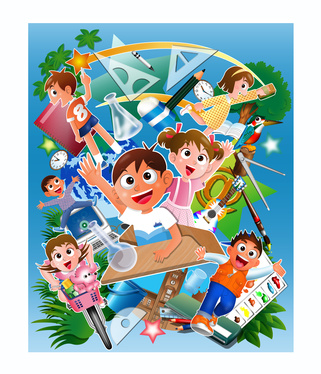STEM Summer Activities!
A MiddleWeb Blog
Summer is upon us and it’s time for kids to officially forget everything they learned during the school year. Right? Well, maybe not right – if schools, communities, and families can keep the learning going.
This summer let’s involve kids in creative and engaging learning. I’m campaigning for a STEM summer – a sunny time filled with kids looking around (really looking) with curiosity. A summer in which kids ask questions, seek answers, and design solutions to problems.
This isn’t as far-fetched as it sounds. Thinking in terms of middle schoolers, what kinds of activities will stimulate their curiosity and help to develop critical thinking and problem-solving mindsets? What kind of approach might adults take to keep the adolescent “summer brain” excited about learning?
My previous blog post, 10 STEM Tips for Parents, and this article at WikiHow, How to Impart STEM Education to Your Children, offer procedures for parents to use as they encourage STEM-related learning that’s fun and engaging. I’ve taken the liberty of tailoring some of the WikiHow suggestions for middle school kids (and a wider adult audience) and adding some more ideas for consideration.
Let’s start with some ideas for how you can support STEM learning for kids.

2. Provide a supportive environment for STEM learning to occur. Make your home or classroom (or other location) a comfortable and encouraging place for learning. If you have set up a STEM activity (some are listed below) expect these results.
• Middle schoolers will definitely make mistakes.
• They will come up with wrong answers and probably fail the first time or two they try to make a working model or usable solution.
• That’s okay. Heck, that’s even good!
• No one learns much from getting something right the first time. It’s the mistakes we make that keep us learning and growing. In STEM work, “failure” is simply a normal step in the learning process, so keep your learning environment risk free.
• Also remember that your rapidly changing middle schooler will find it difficult to learn if hungry or tired or upset.
3. Point out applications of science and technology in everyday life. As opportunities arise, point out that engineers have used science and technology to create most of the things around them – things that they take for granted. TVs, computers, and personal devices are givens. But do your middle schoolers understand that products such as soap, fabrics, automobiles, running water, electricity, and refrigeration were developed to meet needs and wants that people have?
Consider asking them to begin identifying everything they see that was engineered and developed to meet a human need. That would be everything in their line of sight, most likely. Pencils, furniture, door knobs, paint – all of these have been invented to meet human wants and needs.Regularly engage them in conversation about STEM-related topics in way that pertains to their everyday life experiences.

Demonstrate how to carefully observe something, ask thoughtful questions about it, and make an informed guess about what the answers to those questions might be. Think out loud so that your kids can hear you thinking through possible solutions for a problem. (Trust me, they are more likely to listen to you talk to yourself than to listen to you talk to them.)
5. Continually build interest in STEM careers. Talk with children about ways that STEM adds value to the quality of human lives. Make sure they can relate to the examples you pick. You might talk about curing illnesses, creating plastics that don’t pollute, developing increasingly powerful computers, developing improved skin and hair products, building artistic skyscrapers, or engineering new ways to bring clothing designs to the marketplace. STEM/STEAM fields offer opportunities for all.
6. Organize groups of kids in working together on STEM projects and activities. Help them with interpersonal skills by building teamwork skills. Before they begin working in teams, ask them to share behaviors they value in other team members. Guide them to develop a list of ground rules they agree to follow, based on their valued behaviors.
7. Need resources and activity ideas? Challenge your middle school kids to conduct Internet searches for STEM activities they can do. They can locate these on their own using a search engine, or you might direct them to sites such as Discover Engineering, Design Squad Nation, National Geographic Activities and Games, and Bring Science Home. I’m excited about all of those sites, although not every activity is strictly a STEM activity – some are strictly science experiments. To get a feel for the difference, go to the Discover Engineering site and click on the “What’s Engineering” tab.
8. Encourage your middle schoolers to start a STEM group. They might start a local club or they could start a STEM group on a social network such as Facebook if they already use the social network. Using social networks productively is a skill you can help them learn. (Tip: monitor, monitor, monitor!) You might even be in contact with other adults regarding STEM work through online communities.
9. Remember that some middle schoolers like academics. Finally, do you have middle schoolers with more academic interests? No problem. Send them to Khan Academy or similar sites where they can “learn almost anything for free.”
I know you have some activities and ideas in mind for keeping kids engaged over the summer. Are you going to start Lego academies? Just throw a bunch of odds and ends into an area and tell kids to “have at it” and build something? What kinds of ideas do you have that you can share with our readers? I’d love your input.



































Anne, I can attest to the importance of engaging kids in STEM activities during the summer, and even during the school year through local informal STEM programs.
I began involving my two grandsons, Brett & Bryce, in STEM programs when they were about 5 or 6 years old and they loved them. Today, Brett just completed his first year of college majoring in Biology with a minor in Chemistry with a goal of becoming an orthopedic surgeon. He gained his CNA certification when he was a junior in high school and works at a local skilled care facility. Bryce will be a junior in high school next fall and is a leader of his school’s math team.
I truly believe that their STEM experiences gave them the confidence they needed because they provided the opportunity to ask questions, solve problems, and work collaboratively on projects that connected learning to the real world. Thank you for bringing the importance of STEM to the attention of parents.
My question is: how do we get the message out to parents? I know if I hadn’t taken the steps needed to keep Brett and Bryce engaged in STEM programs, their parents would have never thought about it. I find that many parents still don’t understand what STEM even means.
So, how can we do more to educate parents? Maybe the national parent teachers organizations could be charged with doing more outreach in their communities? Does anyone know of a successful working model?
Well, that’s certainly a great question, Cal – let me chew on it. If I can find enough answers, I’ll even blog about it!
Searching out opportunities to write in the mainstream media about the parent role in promoting STEM learning is one step that could really make a difference. We’ll work with Anne to find some outlets for that!
One resource I gave my students this past year (and they LOVED IT) was diy.org . It is based on the idea of scouting with badges to earn, but such a wide range of STEM/Maker ideas that my students spent several “morning work” periods browsing and planning.